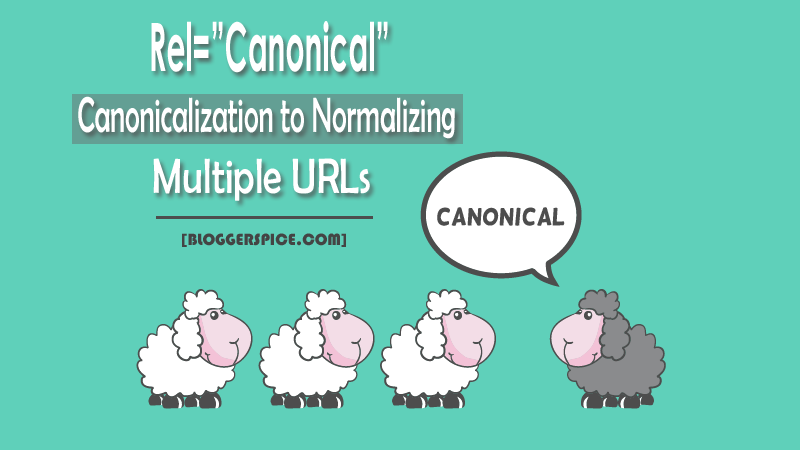Rel=”Canonical” for canonicalization to normalizing multiple URLs.
How you can use canonical URLs to improve link and ranking signals for content available through multiple URL structures or via syndication.

Yes! Rel=”Canonical”
sounds like something strange. Huh! This is an essential SEO element to
normalize multiple URLs. You can visit a specific post from different URLs and
domains entirely. Take a closer look at the below URLs, All links pointing to
the same article with same content, but in real they have different paths
(URLs)
- http://example.com/SEO
- https://example.com/SEO
- http://www.example.com/SEO
In case of Blog Post that assigned to a
specific Label you can visit the post by using different URLs like below.
- http://example.com/SEO/Post-Title
- https://example.com/SEO/Post-Title
- http://www.example.com/SEO/Post-Title
This means for single Blog post we have
multiple URLs. As a result search engine will index 3 URLs for single post; this
is very bad for your site SEO. But if you use rel=”Canonical” tag then
you can solve this issue. rel=”Canonical”
is a function that allows you to set up a preferred URL for a specific
webpage.
What is rel=”Canonical” tag?
“rel=Canonical”
tag is a page level meta tag, generally place
in the HTML header of a webpage for normalizing multiple URLs. As a result when
search robots visit your site then it tells to search engines which URL is the
canonical version of the page being display. The main purpose of using rel=”Canonical” to keep duplicate
content out of the search engine index while combining your page’s strength
into one “Canonical” page.
The “rel=Canonical”
element also known as “Canonical Link”
and it helps the webmasters to specifying the canonical or preferred
version of a webpage. As a result it is able to prevent duplicate content issue
from your website.
Why to use rel=”Canonical”?
This is
absolutely true that correct use of SEO ensure proper website optimization. But
if something becomes wrong then it can be a disaster.
#1:
Search Engine Support is Blotchy
Search engine love specific and spotty. If you
can specify your web page URL by canonical tag then search engine can pick the
right URL, but Google supports canonical tag on both single and across multiple
domains. Bing search engine considers the canonical tag as indication, nothing
else. So try to use rel=”Canonical”
properly thus you can blotch the URL.
#2:
Canonical tag for fixing Duplicate content
If you don’t use any rel=”Canonical” tag then search robot will detect multiple URLs for
single post. But search robot will think you can multiple contents in your
website. So if you use Canonical tag it will stop detecting duplicate content
from your website.
#3:
Consolidating link signals for preferred URL.
rel=”Canonical”
helps search engine to consolidate the
information for the individual URLs on a single and preferred URL. As a result,
no matter how many URLs have to view your Blog Post search engine will get
consolidate with links to preferred one. As a result search engine will avoid
duplicate or similar content.
#4:
To get accurate Analytics report for a single product/topic.
If you are using Analytics tools for tracking
the product performance then it is not possible for multiple URLs on single product
or Post. So for the variety of URLs it’s very difficult to get consolidated
metrics for a specific piece of content. rel=”Canonical”
tag helps the search engine to detect preferred URL and your Analytics tool
will provide accurate tracking metrics.
#5: Determine what URL you want to show.
It is possible to display preferred URL
through rel=”Canonical” tag. So you
can determine what URL to show your audience and what are not. You can prefer
people to reach your post page via
https://example.com/SEO/Post-Title/
URL rather than below URL. https://example.com/SEO/Post-Title?gclid=ABCD
#6:
Addressing syndicated content.
Ranking is necessary for grow your Website
properly. But if you syndicate your content for multiple domains then you should
use rel=”Canonical” tag to
consolidate page ranking to your preferred URL.


How you can use canonical URLs?
We can use rel=”Canonical” to improve link and ranking signals for our Blog
content. But we can implement it different ways. If you wish to use it for a
preferred URL you can simple do it like below:
<head> <link rel=”canonical” href=”https://example.com/SEO/Post-Title/” /> </head>
The above system is manual. If you are using
WordPress then SEO plugin is the solution. And almost all SEO plugins have rel=”Canonical” feature.
In case of Google Blogger site we can easily
use rel=”Canonical” tag for all
WebPages at once. Just follow the below steps-
Step #1: Go to “https://www.blogger.com” and
Sign in to your account
Step #2: From “Blogger
Dashboard” click on ->Template ->Edit HTML
Step #3: And locate
the <head> section in your Blogger template
Step #4: Finally copy following line of markup and paste it below <head>
<link expr:href='data:blog.url' rel='canonical'/>
Step #5: After that hit the “Save template” button
Now when search robot visit your Blog then It
will index only preferred URL only. To check rel=”Canonical” in your Blog just visit any post page and view the
page source by pressing CTRL+U or by right click. You will see the canonical
URL like below. This means you have canonicalized your Blog post URL properly.
<link href='https://example.com/SEO/Post-Title/' rel='canonical'/>
So it’s all about link canonicalization to
normalizing multiple URLs. I hope you have understood the importance of using
it and able to apply in your website.
 |
| Rel=”Canonical” for canonicalization to normalizing multiple URLs. |
Liked this article? Check out for more step-by-step SEO tips in my blog. And don’t forget to share the knowledge!

8 comments
http://www.bloggerspice.com/2013/09/add-random-post-widget-with-large-wide.html
in that widget replace the Blog URL with your Blog URL that you want to show recent post.
http://www.bloggerspice.com/feeds/posts/default?
and simply replace var random_posts = true; with below code
var random_posts = false;
that's it you will able to display recent post from other Blog. :up
Just place the recent widget script in a Static page. then you can display it in a separate page. You can submit sitemap by following tutorial from below URL.
https://www.bloggerspice.com/2015/04/how-to-add-table-of-content-and-sitemap-in-blogger-template.html